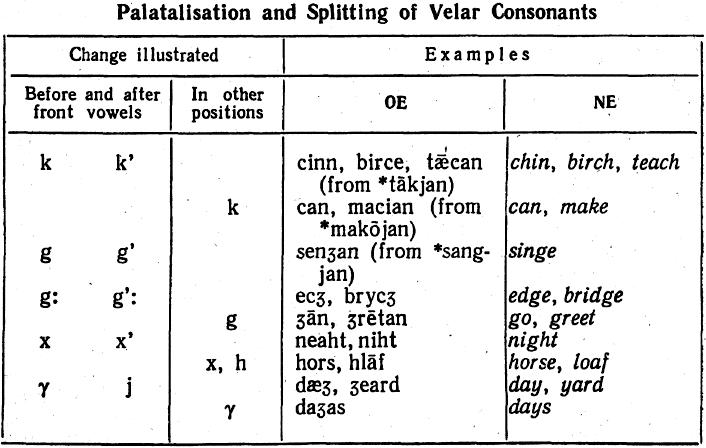
- •Lecture 7 old english phonetics Plan
- •Literature
- •Word Stress
- •Origin of old english vowels Changes of Stressed Vowels in Early Old English
- •Independent Changes. Development of Monophthongs
- •Development of Diphthongs
- •Assimilative Vowel Changes: Breaking and Diphthongisation
- •Old English Vowel System (9th-10th c.)
- •Origin of old english consonants Consonant Changes in Pre-Written Periods
- •Treatment of Fricatives. Hardening. Rhotacism. Voicing and Devoicing
- •Velar Consonants in Early Old English. Growth of New Phonemes
- •Loss of Consonants in Some Positions
- •Old English Consonant System
Velar Consonants in Early Old English. Growth of New Phonemes
In Early OE velar consonants split into two distinct sets of sounds, which eventually led to the growth of new phonemes.
The velar consonants [k, g, x, γ] were palatalised before a front vowel, and sometimes also after a front vowel, unless followed by a back vowel. Thus in OE cild (NE child) the velar consonant [k] was softened to [k'] as it stood before the front vowel [i]: [*kild] > [k’ild]; similarly [k] became [k’] in OE sprǽc (NE speech) after a front vowel but not in OE sprecan (NE speak) where [k] was followed by the back vowel [a]. In the absence of these phonetic conditions the consonants did not change, with the result that lingual consonants split into two sets, palatal and velar. The difference between them became phonemic when, a short time later, velar and palatal consonants began to occur in similar phonetic conditions; cf. OE cild [k’ild], ciest [k’iest] (NE child, chest) with palatal [k'] and ceald, cēpan (NE cold, keep) with hard, velar [k] − both before front vowels.
Though the difference between velar and palatal consonants was not shown in the spellings of the OE period, the two sets were undoubtedly differentiated since a very early date. In the course of time the phonetic difference between them grew and towards the end of the period the palatal consonants developed into sibilants and affricates: [k’] > [tʃ], [g] > [dʒ]; in ME texts they were indicated by means of special digraphs and letter sequences (see the Mod E descendants of the OE examples in Table 8).
Table 8

The date of the palatalisation can be fixed with considerable precision in relation to other Early OE sound changes. It must have taken place after the appearance of [æ, æ:] (referred to the 5th c.) but prior to palatal mutation (late 6th or 7th c.); for [æ, æ:] could bring about the palatalisation of consonants (recall OE spræc, NE speech), while the front vowels which arose by palatal mutation could not. In OE cēpan (from *kōpjan) and OE cyninʒ (with [e:] and [y] through palatal mutation) the consonant [k ] was not softened, which is confirmed by their modern descendants, keep and king. The front vowels [y] and [e:] in these and similar words must have appeared only when the splitting of velar consonants was well under way. Yet it is their appearance that transformed the two sets of positional allophones into phonemes, for a velar and a palatal consonant could now occur before a front vowel, that is, in identical phonetic conditions: cf. OE cyninʒ and cўse (OE king, cheese).
Loss of Consonants in Some Positions
Comparison with other OG languages, especially Gothic and O Icel, has revealed certain instances of the loss of consonants in WG and Early OE.
Nasal sonorants were regularly lost before fricative consonants; in the process the preceding vowel was probably nasalised and lengthened. Cf.:
Gt fimf, O Icel fim, OHG fimf − OE fīf (NE five).
Gt uns, OHG uns − OE ūs (NE us)
Fricative consonants could be dropped between vowels and before some plosive consonants; these losses were accompanied by a compensatory lengthening of the preceding vowel or the fusion of the preceding and succeeding vowel into a diphthong, cf. OE sēon, which corresponds to Gt saihwan, OE slēan, (NE slay), Gt slahan, G. schlagen, OE sæʒde and sæde (NE said).
We should also mention the loss of semi-vowels and consonants in unstressed final syllables. [j] was regularly dropped in suffixes after producing various changes in the root: palatal mutation of vowels, lengthening of consonants after short vowels. The loss of [w] is seen in some case forms of nouns: Nom. trēo, Dat. trēowe (NE tree); Nom. sæ, Dat. sæwe (NE sea), cf. Gt triwa, saiws.
